Most people know that to take the checkered flag, a team needs a talented driver, a skilled and practiced pit crew, and a well-engineered car. Fewer people, however, understand the role that data plays in motorsports and how using it can fuel success. And nowhere is data more valuable than in Formula 1 (F1), where cars employ around 200 physical sensors, which log up to 1,000 channels of data, generating 2 Gigabytes per hour. The challenge: Download the car’s data fast enough so that team engineers have time to analyze it and turn it into actionable tweaks to the cars or instruction for the drivers.
FAST FACT: 15GB of raw car data generated by the Mercedes-AMG Petronas Motorsport’s telemetry system per weekend, with post-processing adding a further 7 GB data.
One F1 team that definitely understands and values data is Mercedes-AMG Petronas Motorsport. The three-time defending champions feast on it. Another team that knows a bit about transmitting data wirelessly is Qualcomm Technologies. Together this week at Mobile World Congress 2017 in Barcelona, these two frontrunners showed off their latest high-speed telemetry news (born from an agreement inked just two years ago) to a group of press and technology analysts: the planned integration of 802.11ad using 60 GHz spectrum into the Mercedes-AMG Petronas Motorsport Wi-Fi telemetry system due for the 2017 U.S. Grand Prix.
From the speedway to your driveway
Outside of racing, you may be wondering if these technologies have any real-world applications. Consider the “trickle-down effect.” Just about every piece of automotive tech you use in your car got its start in auto racing.
While Wi-Fi connectivity has found its way into commercially available cars, 802.11ad via the 60-GHz band has not… yet. The technology and its hardware first needs to be tested in extreme and unforgiving environments before it can be expected to endure years of use (and abuse) in consumers’ cars. And what better place than the F1 arena, where there’s more data being downloaded in a few hours than most of us will need in a week. And the hardware is subjected to the elements: the extreme heat of Abu-Dhabi, the humidity of Malaysia, the rain at Silverstone, the physical structure density at Monaco, the heavy radio-traffic of fans in the U.S., and more.
Because of its ultra-fast speeds, which allow for simultaneous 4K video streaming to multiple devices and lag-free screen mirroring between smartphones and in-car displays, 802.11ad is expected to emerge as the “go-to” for automotive infotainment. The 60-GHz band is high-frequency millimeter wave (mmWave) spectrum band. Such bands are the stepping stone to 5G and provide huge bandwidth for delivering multi-Gbps data rates.
The learnings from the Qualcomm/Mercedes development phase will certainly accelerate the arrival of 60-GHz 802.11ad Wi-Fi for everyday users and contribute to the evolution of 5G connectivity.
FAST FACT: During the 2016 Formula 1 season, the Mercedes-AMG Petronas Motorsport cars could transmit on average the data equivalent of 12 music albums while moving from the beginning to the end of pit lane via the 802.11ac Wi-Fi solution from Qualcomm Technologies.
How the system works
Last season, Qualcomm Technologies and Mercedes-AMG Petronas Motorsport pioneered the use of 802.11ac Wi-Fi for F1 telemetry purposes. While the Mercedes-AMG Petronas F1 cars were on track during Friday practice sessions, the system gathered and processed thermal imaging of the tires. As soon as the cars entered pit lane, the system would begin wirelessly transmitting the data to the team’s Garage. The process is orders of magnitude faster than the traditional method of waiting for the car to stop in the pit box, pushing it into the garage, and plugging in a download cable.
The new system being tested will operate similarly. Upon entering pit lane, the cars will begin transmitting data via 802.11ac in the 5-GHz band. However, once the cars get within 4 meters of an overhead unit in the garage, a special handoff feature will enable the cars to switch to 802.11ad in the 60-GHz band seamlessly and continue the download.
The updated system also features a considerable step up in hardware and connectivity, including the Qualcomm Snapdragon 820 processor with up to 128GB of Universal Flash Storage memory to collect data while the car is on circuit, and a Qualcomm QCA9500 chip to support the 802.11ad Wi-Fi.
Ultimately, the system should translate to less time in the garage and more time on track, giving the Silver Arrows a tremendous edge over their rivals. Beyond that, expect the lessons learned working with 11ad to trickle down to your future auto technologies, and the lessons learned in mmWave to trickle down to future 5G experiences.























